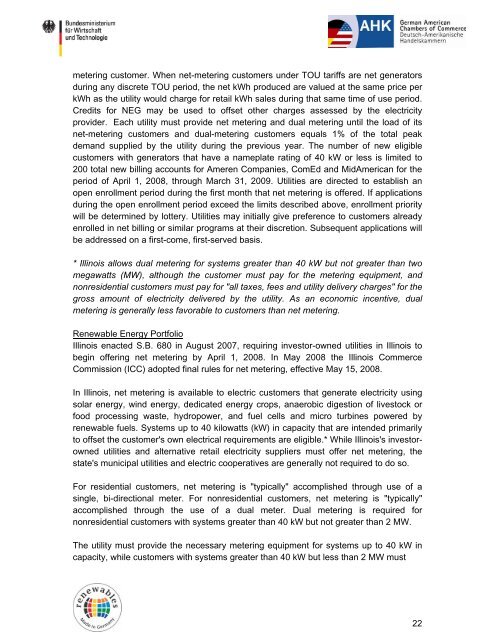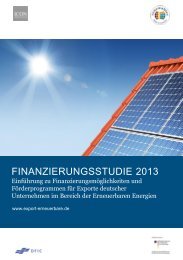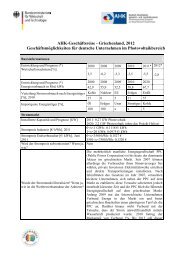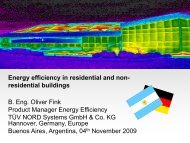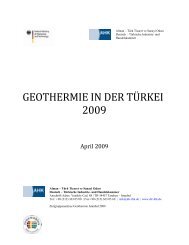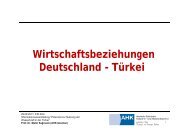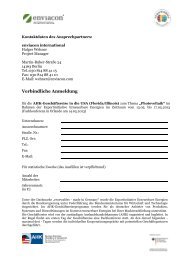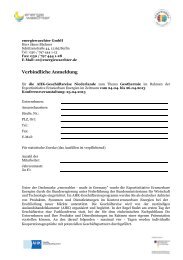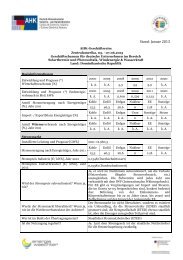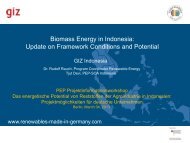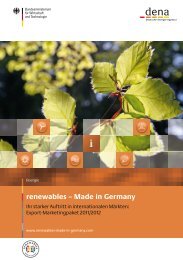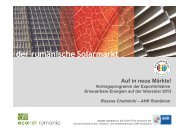PDF: 1,1 MB - Exportinitiative Erneuerbare Energien
PDF: 1,1 MB - Exportinitiative Erneuerbare Energien
PDF: 1,1 MB - Exportinitiative Erneuerbare Energien
- No tags were found...
You also want an ePaper? Increase the reach of your titles
YUMPU automatically turns print PDFs into web optimized ePapers that Google loves.
metering customer. When net-metering customers under TOU tariffs are net generators<br />
during any discrete TOU period, the net kWh produced are valued at the same price per<br />
kWh as the utility would charge for retail kWh sales during that same time of use period.<br />
Credits for NEG may be used to offset other charges assessed by the electricity<br />
provider. Each utility must provide net metering and dual metering until the load of its<br />
net-metering customers and dual-metering customers equals 1% of the total peak<br />
demand supplied by the utility during the previous year. The number of new eligible<br />
customers with generators that have a nameplate rating of 40 kW or less is limited to<br />
200 total new billing accounts for Ameren Companies, ComEd and MidAmerican for the<br />
period of April 1, 2008, through March 31, 2009. Utilities are directed to establish an<br />
open enrollment period during the first month that net metering is offered. If applications<br />
during the open enrollment period exceed the limits described above, enrollment priority<br />
will be determined by lottery. Utilities may initially give preference to customers already<br />
enrolled in net billing or similar programs at their discretion. Subsequent applications will<br />
be addressed on a first-come, first-served basis.<br />
* Illinois allows dual metering for systems greater than 40 kW but not greater than two<br />
megawatts (MW), although the customer must pay for the metering equipment, and<br />
nonresidential customers must pay for "all taxes, fees and utility delivery charges" for the<br />
gross amount of electricity delivered by the utility. As an economic incentive, dual<br />
metering is generally less favorable to customers than net metering.<br />
Renewable Energy Portfolio<br />
Illinois enacted S.B. 680 in August 2007, requiring investor-owned utilities in Illinois to<br />
begin offering net metering by April 1, 2008. In May 2008 the Illinois Commerce<br />
Commission (ICC) adopted final rules for net metering, effective May 15, 2008.<br />
In Illinois, net metering is available to electric customers that generate electricity using<br />
solar energy, wind energy, dedicated energy crops, anaerobic digestion of livestock or<br />
food processing waste, hydropower, and fuel cells and micro turbines powered by<br />
renewable fuels. Systems up to 40 kilowatts (kW) in capacity that are intended primarily<br />
to offset the customer's own electrical requirements are eligible.* While Illinois's investorowned<br />
utilities and alternative retail electricity suppliers must offer net metering, the<br />
state's municipal utilities and electric cooperatives are generally not required to do so.<br />
For residential customers, net metering is "typically" accomplished through use of a<br />
single, bi-directional meter. For nonresidential customers, net metering is "typically"<br />
accomplished through the use of a dual meter. Dual metering is required for<br />
nonresidential customers with systems greater than 40 kW but not greater than 2 MW.<br />
The utility must provide the necessary metering equipment for systems up to 40 kW in<br />
capacity, while customers with systems greater than 40 kW but less than 2 MW must<br />
22


